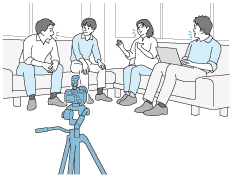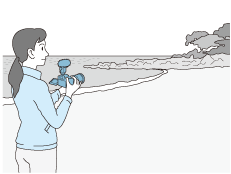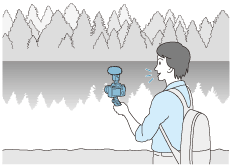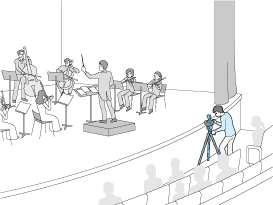Selecting the directivity
By operating the directivity mode dial, you can select the directivity that is best suited for the sounds to record or the recording conditions.
 Super-directional
Super-directional
Sounds in a specific range from the front of this unit are picked, enabling equally clear sound pickup. Super-directional mode enables recording with less reverberations, and is suitable for indoor recording. Super-directional mode is recommended for taking or streaming videos where, for example, the subject is speaking in close proximity to this unit.

 Uni-directional
Uni-directional
A wide variety of sounds from the front of this unit are picked. Uni-directional mode is recommended, for example, for recording conferences and meetings.

 Omni-directional
Omni-directional
Sounds from all directions are equally picked. Omni-directional mode is recommended, for example, for recording whole sounds including environmental sounds.

 Super-directional (Rear)
Super-directional (Rear)
Sounds from the rear of this unit are picked, along with less sounds from the front. Super-directional (Rear) mode is recommended, for example, for taking scenery videos with narratives.

 Super-directional (Front+Rear)
Super-directional (Front+Rear)
Sounds from the front and rear of this unit are equally picked, along with less sounds from the left and right. Super-directional (Front+Rear) mode enables recording of sounds from the subject in front of this unit as well as the voice of the videographer, and is recommended, for example, for recording interview videos.

 Super-directional (Front/Rear) separate
Super-directional (Front/Rear) separate
Sounds from the front (channel 1) and rear (channel 2) of this unit are equally picked, along with less sounds from the left and right. Super-directional (Front/Rear) separate mode enables individual volume adjustment of the front and rear audio after video recording, and is recommended when there is a need for editing the recorded audio.

 (Stereo)
(Stereo)
Realistic video recording is possible by clearly localizing the left (channel 1) and right (channel 2) sound sources. Stereo mode is recommended, for example, for taking videos of moving objects, such as racing cars and trains, or videos of music performances in theaters.

 Ultra-directional
Ultra-directional
Because of the adaptive beamforming technology employed by this unit, the target sound from the front of the unit is captured while any other unnecessary sounds are significantly reduced at the same time. Ultra-directional mode is recommended for making recordings with minimum unnecessary sounds at close range, such as voices around the subject, while keeping moderate environmental sounds at long range, such as the sound of a stream and a chirping bird, in the recordings.
For details about the adaptive beamforming technology, see About the adaptive beamforming technology.

Hint
-
The closer the subject is located to this unit, the clearer the sound can be picked.
Note
-
In the following cases, the sounds from the subject in front of this unit may not be recognized and the audio in recordings may sound lower compared with the one recorded in other directivity modes.
-
Recordings are made in spaces with strong echoes, such as a small room.
-
The subject is located at a distance from this unit.
-
Sounds from the subject are buried in the surrounding noises.
-
The subject is not facing directly toward the front of this unit; it is facing, for example, downward or sideways.
Try one of the following that suits the condition.
-
Change the ATT switch setting.
-
Set the AUTO/MAN switch to “MAN” and adjust the recording volume level with the AUDIO LEVEL dial.
-
Adjust the distance to the subject from this unit or the pointing direction of the unit.
-
Change the directivity to Super-directional mode.
-
-
Depending on the environment and sound source, the following issues may occur. If they seem annoying, change the directivity to Super-directional mode.
-
The audio volume and quality of the surrounding sounds from other than the front of this unit are unstable.
-
The audio quality is unstable. For example, the abrupt clapping-like noise echoes in the audio.
-

